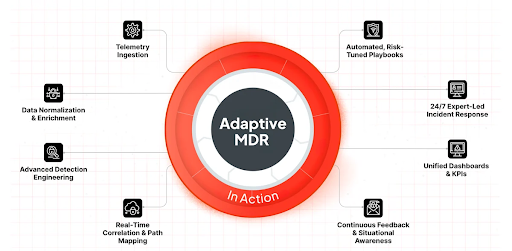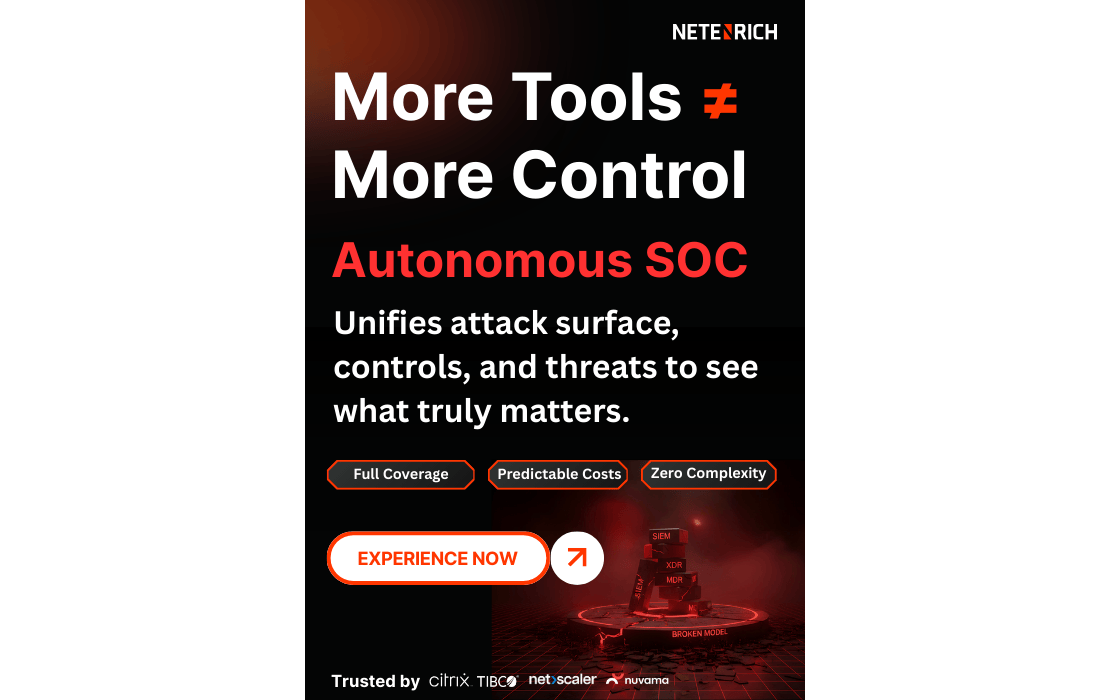Incident Response Automation: Trusting Machines to Accelerate Recovery
Published on November 11, 2025 | Last updated on November 12, 2025 | 5 min read

Key Takeaways
- Manual playbooks create slow, inconsistent response outcomes CISOs can’t defend.
- The Automation Trust Ladder provides a phased path to automation that reduces fear and proves reliability.
- Playbooks, SOAR, and EDR enable consistent containment within minutes.
- Netenrich MDR automates the known while analysts focus on the unknown.
- Automation delivers faster MTTR, stable board-level metrics, higher analyst productivity, and a resilient SOC.
Attackers move faster than defenders can blink. In 2024, the average breakout time for an attack dropped to 48 minutes, with some intrusions spreading in just 51 seconds. Containment that once took hours now must be measured in seconds. Organizations that rely solely on manual playbooks are 40% slower in containment versus those that automate key actions.
According to IBM's Cost of Data Breach Report, every day of delay in containment adds roughly one million dollars in costs to organizations, with additional impacts to reputation and customer privacy.
Yet many executives still hesitate: “What if the machine makes a mistake?” That fear is real, but avoidable. The path forward lies not in leap-of-faith automation but in a phased, trust-building approach called the Automation Trust Ladder. It begins with human-in-the-loop oversight, then shifts safely into semi-autonomous actions on low-risk assets, and ultimately enables full autonomy for high-confidence alerts.
When machines handle the repeatable, well-understood responses and humans focus only on the novel and ambiguous, the “sub-hour breakout window” becomes survivable.
Reactive and Inconsistent Incident Response Is a Core Challenge
Why Manual Response Fails
- Decisions made in silos and with partial context. Assets, threat signals, and control states often live in fragmented tools, forcing analysts to react without full situational awareness.
- Variability across analysts. Two analysts facing the same incident may choose different courses of action, leading to variable containment times.
- Human constraints. Fatigue, off-hour shifts, and uneven skills degrade speed and consistency.
- Process fragmentation. Teams rely on spreadsheets, email, tickets, and manual handoffs rather than a unified workflow.
Impact on the Enterprise
- Growing blast radius. Delayed containment allows attackers to escalate privileges, move laterally, and exfiltrate more.
- Unpredictability over slowness. When MTTR (mean time to recover) varies wildly, executives cannot model risk or commit to response outcomes.
- Board-level risk. Boards don’t accept incident processes they can’t measure, audit, or defend. Inconsistent response introduces reputational and regulatory risk.
Takeaway for Executives
Inconsistent incident response is often more dangerous than a slow response. Fixing it demands automation, done the right way. Automation must build trust, not fear.
Why Automate Incident Response?
Automation changes the equation by removing variability and compressing time. It does not remove the need for analysts; it simply pulls variability from their work. Some ways automation brings value to a business are:
- Speed: Automated actions occur in seconds rather than hours.
- Scale: Hundreds of alerts can be triaged consistently without increasing staff.
- Consistency: Responses are codified, so decisions no longer rely on analyst judgment.
- Predictability: Metrics stabilize, enabling boards to trust MTTR and MTTD reports.
- Resilience: Faster, consistent response aligns with compliance and continuity requirements.
Automation is about eliminating guesswork, not humans. With the right governance, CISOs gain confidence that incident response becomes repeatable, measurable, and defensible. Analysts get time back to focus on high-value investigations, and boards can trust that outcomes aren’t random.
What’s Stopping Organizations from Automating Today?
Despite the clear value, many organizations hesitate to adopt response automation. The biggest barrier is often cultural. Since SOC, IT, and DevOps teams operate in separate silos with different priorities, the lack of shared ownership makes it hard to trust an automated action that could ripple across multiple environments.
Beyond organizational divides, other barriers appear:
- Alert accuracy concerns: According to industry surveys, about 77% of CISOs express a lack of full confidence in alert quality. If the data is noisy, automation feels dangerous. Executives worry automation might isolate the wrong asset or shut down a business-critical system.
- Analyst resistance: Teams fear that machines will override or replace them.
- Board-level trust gap: Executives remain reluctant to hand critical systems to an algorithm without checks.
- Data quality issues: Fragmented logs, missing context, and false positives make automated responses appear dangerous.
During a roundtable, one CISO explained it this way: “When a SOC analyst realizes a machine is part of a payment gateway, their prioritization changes entirely.” Analysts can add business context when making decisions, while leaders fear machines may not.
To address these barriers, organizations should adopt a phased approach, known as the Automation Trust Ladder.
The Automation Trust Ladder: Tackling Fear Step by Step
The Automation Trust Ladder is a roadmap that enables CISOs to adopt automation without taking an all-in risk. Each rung builds confidence, provides measurable results, and reduces fear. When enrichment is strong and adoption is phased, confidence grows across analysts, managers, and executives.
| Barrier (Fear) | Ladder Step | Reassurance / Resolution |
|---|---|---|
| Fear of mistakes: “What if the machine takes the wrong action?” | Level 1: Human-in-the-Loop Approvals | Automation suggests actions, while a human approves. Boards retain control while seeing early proof that automation supports speed without introducing risk. |
| Job security concern: Analysts fear losing control or being replaced | Level 2: Semi-Autonomous on Routine Tasks | Automate safe, repetitive tasks (password resets, quarantining non-critical endpoints, user notifications). Analysts see less toil, more time for complex investigations. Cultural resistance begins to ease. |
| Board trust gap: Reluctance to give machines authority over critical assets. | Level 3: Full Autonomy for High-Confidence Alerts | Autonomy only triggers for high-confidence, validated detections (e.g., confirmed malware, validated IOCs). Governance, enrichment, and telemetry reduce risk. Boards gain data-backed evidence that autonomy is safe, controlled, and governed. |
How Do Playbooks Standardize Response Actions?
Playbooks are the first rung of the Automation Trust Ladder. Their systemic "if-then" logic ensures that every incident follows a consistent path.
- Codification of best practices. Phishing, ransomware, and insider threats each get a workflow that enforces escalation, containment, and remediation steps.
- Auditability & compliance. Every action is logged, time-stamped, and traceable.
- Predictability. Regardless of who is on call, a given alert results in the same sequence of steps.
- Baseline for automation. Playbooks are the safe surface where automation begins — human or machine can “drive” the same process.
In effect, playbooks are the foundation for the Trust Ladder, enabling dynamic transition from human-guided to machine-driven incident responses. The responses become measurable, auditable, and ready for automation to take on a larger role.
Which Tools Enable Faster Containment and Recovery?
To translate playbooks into action, security teams rely on a toolkit of automation enablers:
- SOAR platforms orchestrate multi-tool responses, ensuring that EDR, SIEM, and communication channels act in sync.
- EDR solutions cut dwell time by isolating compromised endpoints in seconds.
- Automated enrichment layers threat intelligence and identity context onto alerts.
- Automated recovery handles credential resets, patching, and service restoration.
When these tools are properly integrated with playbooks and governance, the path from detection to containment can go from hours to minutes.
How Netenrich MDR Delivers Incident Response Automation
Netenrich Managed Detection and Response (MDR) operationalizes the Trust Ladder in production environments. Executives see automation introduced step by step, with audit trails that show how each action was taken and why.
Automate the known
Netenrich MDR takes routine cases off the table. Phishing, ransomware alerts, and insider misuse are resolved with prebuilt playbooks so analysts can focus on new and complex threats.
ACT context
Automation runs with full situational awareness. Assets, controls, and threats (ACT) are correlated so that actions are not triggered on raw alerts. This ensures containment decisions are based on the real business impact of the event.
Phased adoption for trust
Human-in-the-loop flexibility enables organizations to climb the Trust Ladder at their own pace. This flexibility makes automation managed rather than a one-time switch.
End-to-End Orchestration
Netenrich MDR connects the full stack of security and IT systems. This enables a containment decision in one tool to cascade across all relevant systems as a unified incident case.
Continuous Optimization
Netenrich MDR updates playbooks with fresh threat intelligence and analyst feedback, keeping automation aligned with the current threat landscape.
Key Benefits of Faster Recovery
Adopting automation through the Trust Ladder improves the efficiency of the SOC. It results in:
- Lower breach costs and compliance exposure: Faster containment reduces the window for data loss and limits penalties tied to regulations.
- Stable SOC performance: Incidents follow the same workflows, giving leaders confidence that outcomes will not vary from case to case.
- Better use of analyst time: With repetitive triage removed, staff can focus on meaningful investigations.
- Stronger reporting: Metrics like MTTD and MTTR become steady and reliable enough for board-level reviews.
- Preserved trust: Consistent, visible recovery during incidents shows customers and partners that services remain under control, even in a crisis.
The differentiator: Netenrich doesn’t just speed recovery, it enables trusted automation that you can present confidently to boards, clients, and regulators. Automation is phased, context-aware, and backed by 24/7 expert oversight.
From Reactive to Resilient
Manual incident response is no longer viable due to its inconsistency and unsustainability. Automation is the only way to keep pace with adversaries who now move faster than ever before.
But, automation must be introduced safely and strategically. Here is where the Automation Trust Ladder comes handly. It brings in confidence, giving CISOs, analysts, and boards a phased path to defendable autonomy. Playbooks, integrated SOAR/EDR, and enrichment technologies allow orchestration of containment in minutes.
Netenrich MDR operationalizes the Trust Ladder, automating the known and letting analysts focus on the unknown. Continuous validation, tuning, and metrics lead to stable, reliable performance, measurable ROI, and executive confidence.
You don’t just get faster containment; you get faster, board-defensible recovery. Want to see how Netenrich MDR introduces automation with control?
References:
https://www.crowdstrike.com/en-us/press-releases/crowdstrike-releases-2025-global-threat-report/
Related Articles
Subscribe for updates
The best source of information for Security, Networks, Cloud, and ITOps best practices. Join us.








